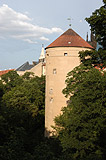Mihulka Powder Tower
 Mihulka Powder Tower was built at the end of the 15th century by the King Vladislav II as a cannon bastion and a part of the Prague Castle northern fortification. At that time it was one of the most modern and effective fortifications. Whether the cannon bastion really worked has never been proved. In 1541 the tower was completely damaged by the catastrophic fire in the Lesser Town and Hradcany. Mihulka Tower was rebuilt for Tomas Jaros, a gunsmith and bell founder, who used the Powder Tower as his home and workshop. In this tower he made the Singing Fountain in the Royal Garden around Royal Summer Palace and Prague’s biggest bell Zikmund (situated now in the Bell tower of St Vitus Cathedral). According to the legend if the heart of the bell breaks, it is the omen of bad times.
Mihulka Powder Tower was built at the end of the 15th century by the King Vladislav II as a cannon bastion and a part of the Prague Castle northern fortification. At that time it was one of the most modern and effective fortifications. Whether the cannon bastion really worked has never been proved. In 1541 the tower was completely damaged by the catastrophic fire in the Lesser Town and Hradcany. Mihulka Tower was rebuilt for Tomas Jaros, a gunsmith and bell founder, who used the Powder Tower as his home and workshop. In this tower he made the Singing Fountain in the Royal Garden around Royal Summer Palace and Prague’s biggest bell Zikmund (situated now in the Bell tower of St Vitus Cathedral). According to the legend if the heart of the bell breaks, it is the omen of bad times.
The emperor Rudolph II used the tower as a laboratory for his alchemists who tried to convince him that they could turn lead into gold. One of the alchemist was Edward Kelley. After that Mihulka Tower stored gunpowder, thus its name. But again, the tower suffered serious damages when the gunpowder exploded during the occupation by Swedish army in 1649. Mihulka Powder Tower stored the gunpowder until 1754. After that the tower served as a home of the sacristans of St Vitus Cathedral.
In 1967-80 the tower was reconstructed as a museum and in 1982 was open to the public. The exposition showed the history of bell foundry and alchemy practices during the reign of Rudolf II. Until 1989 all the windows leading to the Dear Moat were blinded so that the visitors’ looks could not disturb the last communist president Gustav Husak in his house in the opposite Royal garden. Now you can visit in Mihulka Powder Tower the exhibition of Military History Institute.
Address:
Praha 1 – Hradcany
How to get there:
A passage-way from Vikarska street will take you to the bailey of Prague Castle and the tower Mihulka.
Opening hours:
April – October 9:00 – 17:00
November – March 9:00 – 16:00